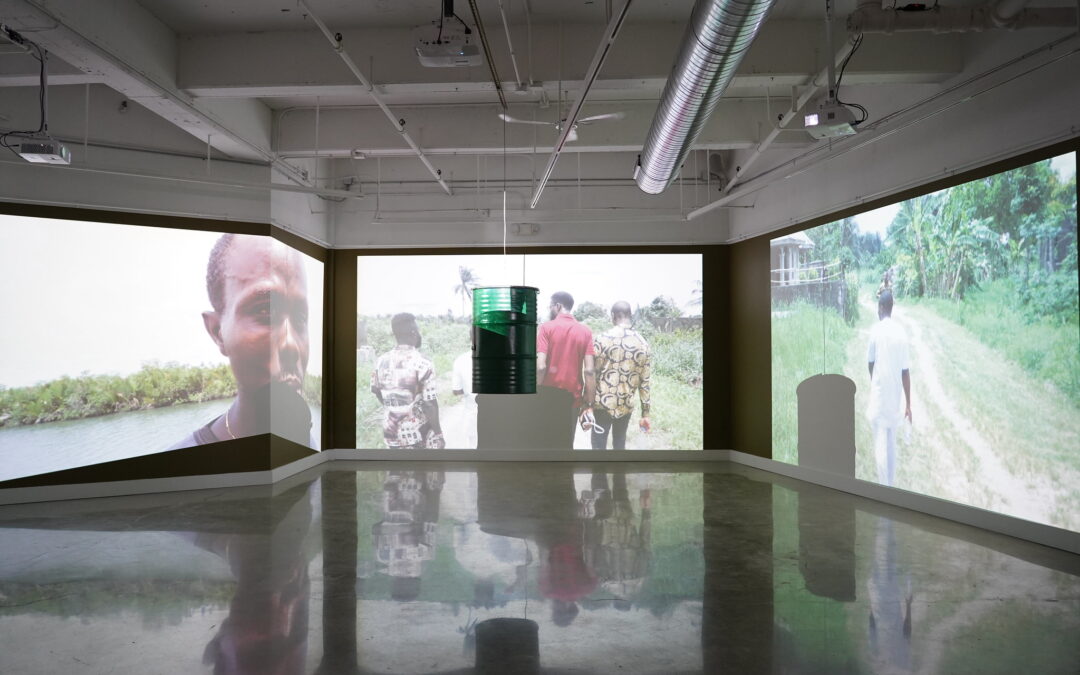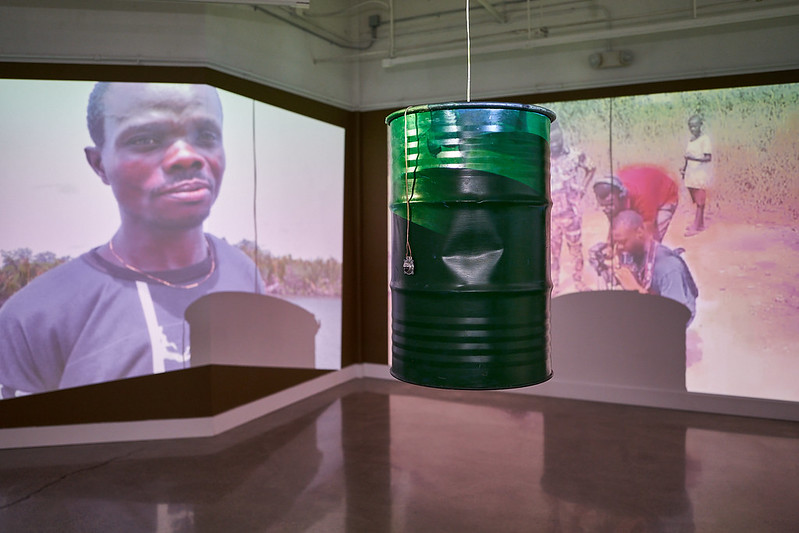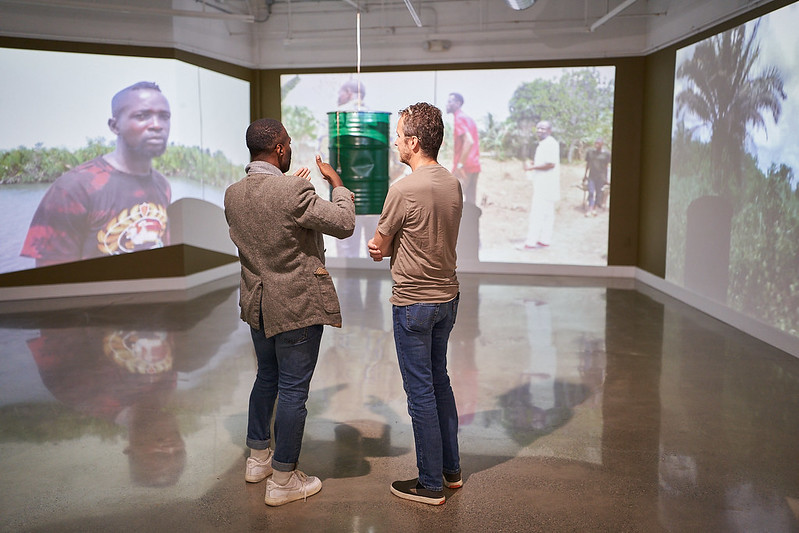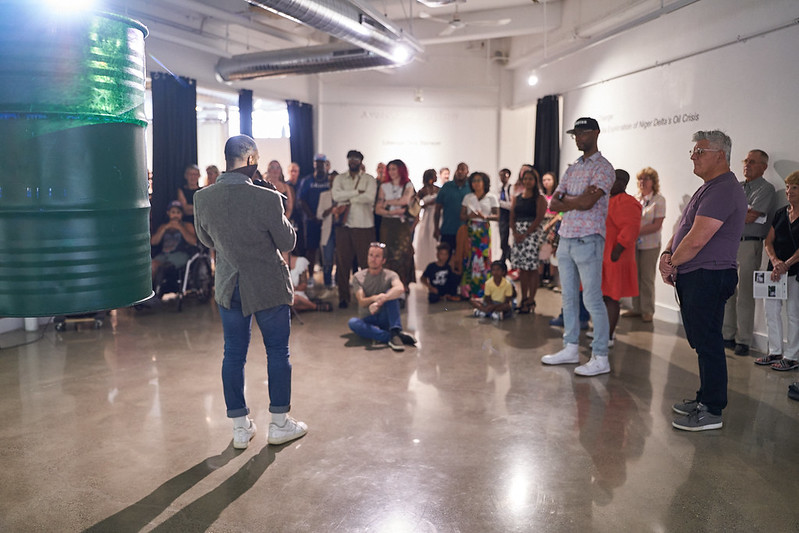Date/Time
Date(s) - 07/27/2024 - 09/07/2024
12:00 am
Location
Buffalo Arts Studio
Categories
Opening Reception, Friday, July 26, 2024, 5:00—8:00 pm
Part of M&T Bank 4th Friday @ Tri-Main Center
Fueling Change
by Léwuga Tata Benson
Part I: The Journey
Fueling Change centers around my recent travel to Port Harcourt, Nigeria, a city in the southwestern region of Africa. This project reflects the villages I visited and the local people I interacted with. My encounters there opened my eyes to the environmental issues, regional struggles, and socio-political quagmires that many in these areas face daily. My goal with Fueling Change is for audiences to gain an intimate, ground-level view of the complex realities unfolding in places like Port Harcourt where resources have been extracted with little concern for the people directly impacted. Leveraging my position of privilege, I aim to connect those far removed from the harsh realities of oil spills and environmental calamities with people for whom this is a reality. By revealing the lives of those who contend with oil disasters daily, I hope to foster an appreciation for these remote communities. Their labor generates the commodity that we in the US rely on, and it’s crucial to recognize and respect their contributions and struggles.
The Niger Delta, rich with wildlife and natural resources, is home to indigenous communities, including the Ogoni people, an ethnic group I am part of. The Ogoni rely on the Delta’s assets, such as fish and rich vegetation, for survival and sustenance. In 1957, British oil producer Shell Oil Company discovered crude oil in the Delta. Before Nigeria’s independence on October 1, 1960, it was a British colony, with the UK extracting many of its natural resources, including crude oil. At the height of crude oil operations in this region, more than 620,000 barrels of oil were extracted annually. The high volume of extraction combined with faulty piping, lax safety procedures, and improperly sealed oil rigs, resulted in massive oil spills and gas flares, some of which continue to pollute the region to this day.
I embarked on this journey to document the ongoing issues in Port Harcourt and to better understand why my family fled to America. I was seven years old when we emigrated and I remember little of my life there. Returning to the Delta was crucial as I needed to see firsthand the side effects of oil extraction on Ogoni lands. Delta villages such as Obia, Akpor, and Teera-Ue are special to me because they are part of my family’s homeland—my late uncle and grandfather were chiefs in these villages. My grandmother owned lands there, which she passed down to her children, and although some sold their shares, others still live there today. These villages are beautiful but they lack electricity, plumbing systems, and paved roads. It was profoundly unsettling to see these areas in pitch darkness due to a lack of electric power, residents urinating in the woods due to no proper sanitation systems, and many still cooking their meals over a wooden fire. It was a culture shock because, coming from America, I had become accustomed to basic amenities like portable drinking water, roads, and electricity.
To navigate these local villages and document the still-operable but inactive oil rigs, I enlisted the help of my cousins and other local guides. Since I still spoke the language, I was allowed deeper into the Delta and onto Ogoni lands where I documented the oil rigs and the surrounding environment. Initially, I feared for my safety, as many of the locals we met carried machetes and seemed agitated about encountering visitors. In retrospect, I had nothing to fear; these were people who had become apprehensive and suspicious of outsiders whose only goal seemed to be filming them and their struggles for selfish gain. With this realization in mind, I decided not to document the oil spills and polluted waters. That narrative has been well covered by news media outlets. Instead, I focused on the local people— their history and their contemporary lives.
Many global news outlets cover the violence that occurs in the protesting of oil activities, often portraying the Ogoni people as agitators. Perhaps this is because the Ogoni were the first ethnic group in the Delta to stand up against oil extraction and the natural disasters that come with it. A notable incident was the 1993 Ogoni-Andoni war, which claimed the lives of nine people and displaced countless others. Too often, organizations such as the Movement for the Survival of the Ogoni People (MOSOP), created to protect the Delta’s environment and natural resources through nonviolent protests, are portrayed as radical because they stand in the way of oil extraction and revenue for the Nigerian government and their international partners. The Ogoni people created the Ogoni Bill of Rights, which disallows oil drilling by recognizing the Ogoni’s sovereignty and right to self-determination. As a result, the Ogoni have been denied political power at a state and national level. In other words, they are being punished for protecting the Delta’s natural resources and environment. Although the Ogoni people and broader international actors successfully negotiated the end of oil extraction on Ogoni lands in 1996, the decommissioned rigs remain scattered throughout the countryside. The lack of a current plan to remove the rigs or remediate this land will increasingly pollute the region over time.
Part II: The Installation
In Ogoni culture, it is common practice to clean one’s hands before eating, a gesture that signals respect and appreciation for life’s blessings. Fueling Change repurposes this practice with a silver bowl containing water, encouraging visitors to dip their hands in the water to cleanse their minds of preconceived notions. This act sets the intention for an open-minded and present experience of the installation.
The live-action footage gathered during my travels to Port Harcourt, Nigeria, is central to Fueling Change. These videos are projected onto the gallery walls, large and imposing, symbolizing the enormous and complex reality the Ogoni people face—from oil spills and lack of electricity to diseases caused by oil-polluted water.
On the left screen, close-up shots of local Ogoni people standing by the water’s edge stare out at the viewer. A second screen shows a montage of locals walking through the villages, greeting one another, and talking about the land while searching for oil rigs. The third screen features people walking and running, with most of the footage modified to create a sense of chaos and confusion. The installation also includes a single oil drum hanging with a soundscape emanating from within. Together, the installation simplifies and distills the complicated realities of the Niger Delta. The oil drum’s kelly green color, juxtaposed with the brownish-green painted gallery walls, underscores the merging and blurring boundaries between the natural environment and man-made objects. The green oil drum simultaneously blends into the background and reflects the projections, reminding us of the inextricable nature of these opposing elements.
The oil drum also casts shadows onto each projection. The distorted and overlapping footage of these projections, as well as the shadows, illustrate the disrupted realities and convoluted nature of the Ogani people’s struggles with their environment. The combination of physical objects and digital elements emphasizes the tactile reality in Port Harcourt. The oil drum symbolizes the embodied history of the local area and its people, while the three-channel projections, interspersed with live-action footage of people, landscapes, and oil rigs, create an immersive experience. The watery, metallic soundscape energizes the gallery space with the same chaotic reality I encountered during my trip. Audio recordings of villagers discussing local politics reverberate off the hanging metal oil drum via a transducer, transporting the viewers into the same disoriented position I occupied among the indigenous people.
While the hanging oil drum captures the unfortunate reality of the local inhabitants, it is ultimately the viewers, through their interaction with the drum and other elements of the installation, who liberate the disembodied voices by providing an audience willing to listen to their stories.
Artist Biography
As an interdisciplinary artist and filmmaker, Léwuga Tata Benson’s work bridges cultures and explores the dynamic interplay between identity, environmental sustainability, and human connection. Rooted in his Ogoni heritage in Nigeria, Benson draws inspiration from the tradition of repurposing to prevent waste. This ethos infuses Benson’s art, as seen in installations like The Land Gives Until It No Longer Can (2022), Hang in There (2022), Traces of Displacement (2023), Carrying Identity, Carrying The Weight (2023), and Fueling Change (2024). Embracing Ogoni storytelling, Benson’s work engages all the senses, integrating songs, dance, and props, creating a holistic experience for visitors. His artistic practice incorporates these traditions to create immersive narratives that provoke thought, foster empathy, and celebrate cultural richness. Benson’s journey has been marked by awards and accolades, including the NYSCA 2024 Support for Artists Grant and the Gregory Capasso Scholarship for outstanding work in film.
Part of Waterfront View Series, which is funded in part by the National Endowment for the Arts.
Photos by Nilson Rivera Photography.




